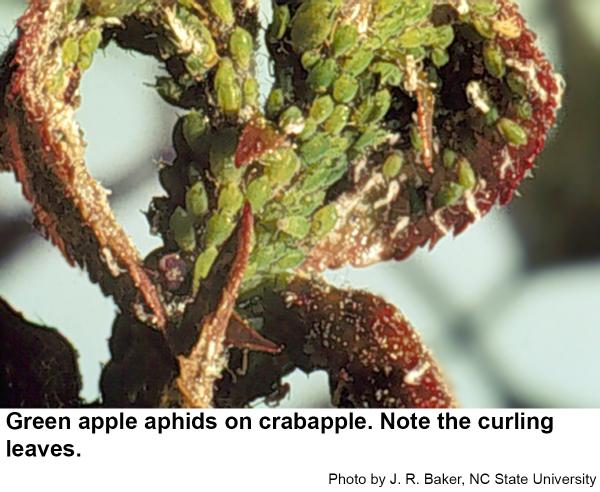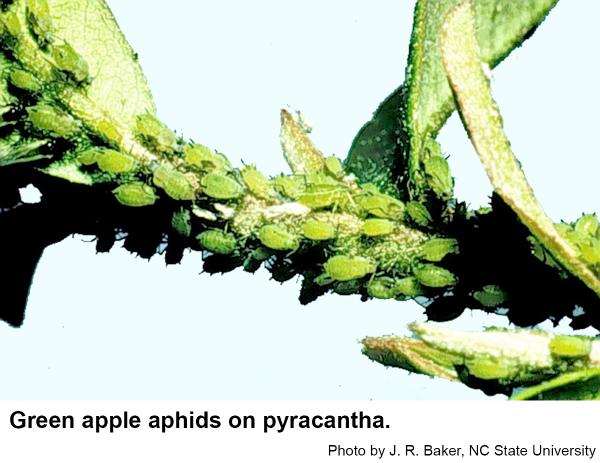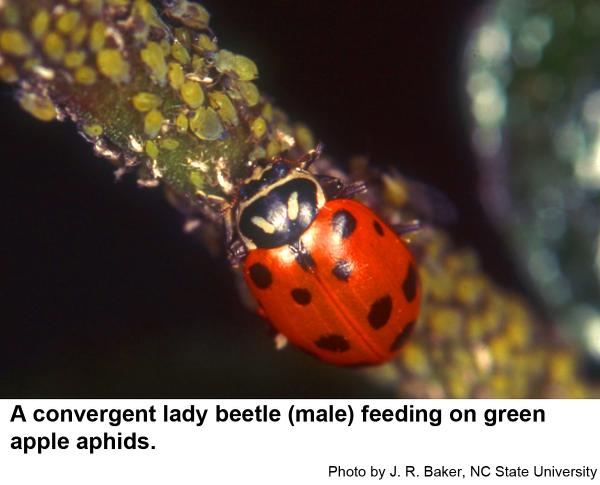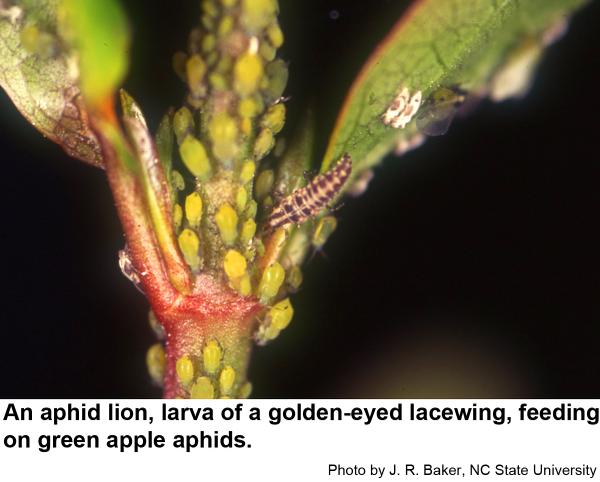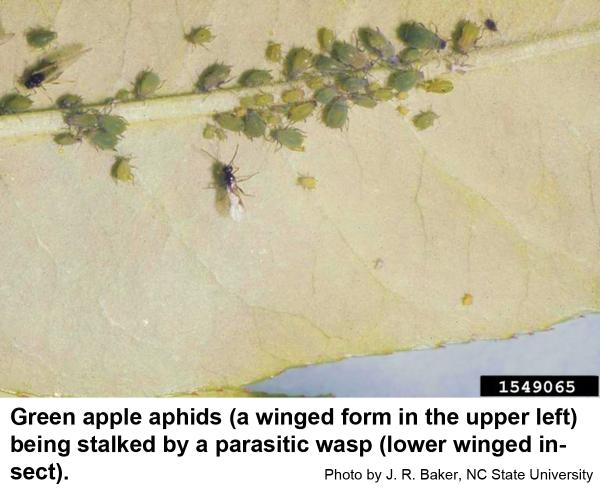Description and Biology
The green apple aphid, Aphis pomi, is yellowish to light green or dark green. Females grow to almost 1/8 inch long and have dark tips of the antennae, dark feet, and very dark cornicles (appendages at the rear of the insect that resemble dual exhaust pipes of a hot rod). In addition, there is a very dark, tail-like structure called the cauda. This aphid may have wings or wing buds or be completely wingless. If present, the wings are transparent with a dark spot on the outer edge. Nymphs are small, dark green to green, and have grayish appendages. Nymphs resemble adult wingless green apple aphids, but they are smaller and the cornicles are shorter especially on young nymphs. Eggs are tiny and yellowish-green when newly laid, but soon turn shiny black. After overwintering as eggs on suckers and terminal growth of apple, female nymphs hatch the following spring and feed on new, tender growth. As they develop into adults some develop wings whereas others are wingless. Winged green apple aphids fly to other rosaceous hosts as well as other apple trees. Throughout the growing season, only females that give birth to live female nymphs are the forms produced. Each aphid lives about a month and gives birth to about 50 nymphs. Nymphs molt four times as they mature into adults. New adults start giving birth about a day after their last molt. We have as many as sixteen generations per year in North Carolina. The last generation develops as males and egg-laying females that mate and fly to apple to deposit overwintering eggs. Each female lays one to six eggs. Apple is the primary host (the only host on which this aphid lays eggs). Although green apple aphid is subject to wide fluctuations in abundance, it usually occurs yearly in many landscapes. Green apple aphids are most abundant in warm, humid weather when shrubs are sprouting new growth. Populations at any one landscape may fluctuate greatly because these aphid only feed on tender, new growth so the availability of new shoots regulates the population. Lady beetles, parasites, and diseases also take a toll on green apple aphids.
Host Plants
Green apple aphids feed on abelia, crabapple, hawthorn, loquat, mountain ash, pear, pyracantha, spirea, and quince as well as commercial apples. Their feeding often causes terminal growth to curl. Like other aphids, green apple aphids excrete honeydew in which sooty molds sometimes grow. Heavily infested plants are often sticky with honeydew, dark with sooty molds, disfigured by distorted new growth, and speckled with whitish cast aphid skins. Sooty molds can hinder leaf function and certainly detract from the appearance of infested plants. Green apple aphids feed primarily on leaves or succulent growth of tender shoots. They typically do not harm the health of established trees, but high populations can stunt young plants.
Residential Recommendations
Natural enemies such as lady beetles, lacewings, syrphid flies, predaceous midge larvae, and predatory bugs often keep green apple aphids under control if they are not killed or repelled by broad-spectrum insecticide sprays. Sprays of insecticidal soap, horticultural oils, and neem insecticides give adequate suppression of green apple aphids, are less damaging to natural enemies, and are organically acceptable.
Other Resources
- Aphids on Ornamental Landscape Plants. Frank, S. 2009. Entomology Insect Notes, NC State Extension Publications.
- Apple Aphids. Alston, D. et al. 2010. Utah State University Extension and Utah Plant Pest Diagnostic Laboratory. Utah Pests Fact Sheet. ENT-143-98.
- Green Apple Aphid, Scientific name: Aphis pomi. Wunderlich, L. R. et al. 2016 (revised). How to Manage Pests, UC Pest Management Guidelines, Apple, University of California Agriculture & Natural Resources, UC IPM, Statewide Integrated Pest Management Program.
- Green Apple Aphid / Spirea Aphid. Walgenbach, J. 2015. NC State Extension Publications.
-
Horticultural Oils for Ornamental Plants. Frank, S. et al. 2018. Entomology Insect Notes, NC State Extension Publications.
-
Sooty Molds. Frank, S. et al. 2002. Entomology Insect Notes, NC State Extension Publications.
- Extension Plant Pathology Publications and Factsheets
- Horticultural Science Publications
- North Carolina Agricultural Chemicals Manual
For assistance with a specific problem, contact your local N.C. Cooperative Extension center.
This Factsheet has not been peer reviewed.
Publication date: Feb. 21, 2019
Reviewed/Revised: Dec. 20, 2023
Recommendations for the use of agricultural chemicals are included in this publication as a convenience to the reader. The use of brand names and any mention or listing of commercial products or services in this publication does not imply endorsement by NC State University or N.C. A&T State University nor discrimination against similar products or services not mentioned. Individuals who use agricultural chemicals are responsible for ensuring that the intended use complies with current regulations and conforms to the product label. Be sure to obtain current information about usage regulations and examine a current product label before applying any chemical. For assistance, contact your local N.C. Cooperative Extension county center.
N.C. Cooperative Extension prohibits discrimination and harassment regardless of age, color, disability, family and marital status, gender identity, national origin, political beliefs, race, religion, sex (including pregnancy), sexual orientation and veteran status.

